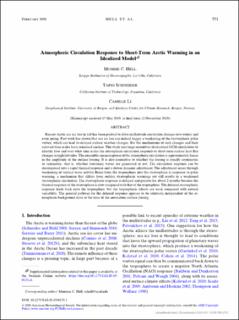| dc.contributor.author | Hell, Momme | |
| dc.contributor.author | Schneider, Tapio | |
| dc.contributor.author | Li, Camille | |
| dc.date.accessioned | 2021-07-16T08:16:13Z | |
| dc.date.available | 2021-07-16T08:16:13Z | |
| dc.date.created | 2019-09-23T13:50:53Z | |
| dc.date.issued | 2020 | |
| dc.identifier.issn | 0022-4928 | |
| dc.identifier.uri | https://hdl.handle.net/11250/2764604 | |
| dc.description.abstract | Recent Arctic sea ice loss in fall has been posited to drive midlatitude circulation changes into winter and even spring. Past work has shown that sea ice loss can indeed trigger a weakening of the stratospheric polar vortex, which can lead to delayed surface weather changes. But the mechanisms of such changes and their relevant time scales have remained unclear. This study uses large ensembles of idealized GCM simulations to identify how and over what time scales the atmospheric circulation responds to short-term surface heat flux changes in high latitudes. The ensemble-mean response of the atmospheric circulation is approximately linear in the amplitude of the surface forcing. It is also insensitive to whether the forcing is zonally asymmetric or symmetric, that is, whether stationary waves are generated or not. The circulation response can be decomposed into a rapid thermal response and a slower dynamic adjustment. The adjustment arises through weakening of vertical wave activity fluxes from the troposphere into the stratosphere in response to polar warming, a mechanism that differs from sudden stratospheric warmings yet still results in a weakened stratospheric circulation. The stratospheric response is delayed and persists for about 2 months because the thermal response of the stratosphere is slow compared with that of the troposphere. The delayed stratospheric response feeds back onto the troposphere, but the tropospheric effects are weak compared with natural variability. The general pathway for the delayed response appears to be relatively independent of the atmospheric background state at the time of the anomalous surface forcing. | en_US |
| dc.language.iso | eng | en_US |
| dc.publisher | American Meteorological Society | en_US |
| dc.title | Atmospheric Circulation Response to Short-Term Arctic Warming in an Idealized Model | en_US |
| dc.type | Journal article | en_US |
| dc.type | Peer reviewed | en_US |
| dc.description.version | publishedVersion | en_US |
| dc.rights.holder | Copyright 2020 American Meteorological Society | en_US |
| cristin.ispublished | true | |
| cristin.fulltext | original | |
| cristin.qualitycode | 2 | |
| dc.identifier.doi | 10.1175/JAS-D-19-0133.1 | |
| dc.identifier.cristin | 1727851 | |
| dc.source.journal | Journal of the Atmospheric Sciences | en_US |
| dc.source.pagenumber | 531-549 | en_US |
| dc.relation.project | Norges forskningsråd: 255027 | en_US |
| dc.identifier.citation | Journal of the Atmospheric Sciences. 2020, 77 (2), 531-549. | en_US |
| dc.source.volume | 77 | en_US |
| dc.source.issue | 2 | en_US |
